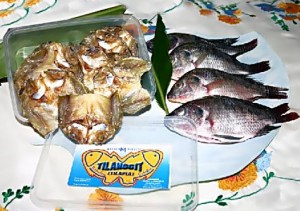 Declining wild fisheries and more demand for animal protein have opportunities for aquaculture. Tilapia is a suitable fish for culture. Its short culture period is ideal. In tilapia farming for tilanggit production, fingerlings are cultured at a high stocking density in a shorter period to body weights of 20-30 grams of the fish then processed to produce boneless dried tilapia called tilanggit.
Declining wild fisheries and more demand for animal protein have opportunities for aquaculture. Tilapia is a suitable fish for culture. Its short culture period is ideal. In tilapia farming for tilanggit production, fingerlings are cultured at a high stocking density in a shorter period to body weights of 20-30 grams of the fish then processed to produce boneless dried tilapia called tilanggit.
Concrete tanks measuring 10-500 square meters with a depth of 1-1.5 m and provided with efficient life support systems, are stocked with 1 to 2 g fingerlings at a stocking rate of 100-150 fingerlings per cubic meter. Water exchange is done daily at 10-20% of the total volume. Home-made or commercial feeds with 25-30% crude protein content are used at 7% of body weight, adjusted every 15 days.
Culling for heterogenous individual growth (HID) is done starting after 60 days of culture and fish are processed for tilanggit. Total harvest, with survival rates of 90-95%, is done after 90 days of culture. Recovery is 20% dried boneless young tilapia (tilanggit) and 5% dried fish bones. Profitability shows a high return on investment (ROI) of 33.23% with a payback period of three years.
Protocol for Tilanggit Production
Grow-Out
- Tank preparation and water filling – Tanks are disinfected, cleaned, filled with clean water. Aerators and pumps provided.
- Stocking of fingerlings – 1-2 gram fingerlings are stocked at 100-150 fingerlings per square meter
- Feeding management – Commercial feeds with 25% protein are given
The stocking rate (fingerlings) per square meter for tilanggit production can be higher than the stocking rate for semi-intensive tilapia culture, which is five fingerlings per square meter. This is because the stocks are to be harvested in a short time and are not meant to grow to market size.The stocking density for tilanggit production can be as high as 50 to 150 pieces of size 17 fingerlings (0.56 g-1.5 g) per square meter.
Artificial aeration and frequent water change is necessary for this culture system. Feeding rate (commercial feeds and rice bran), on one hand, is computed at 5 percent to 7 percent of average body weight at start of culture period down to 2 percent to 3 percent at the end of the three-month cycle.
Processing
- Deboning
- Preparation of brine solution – Mixture of 4% salt, 0.5% garlic and 0.3% black pepper in water, then marinate for 6-8 hours.
- Fish drying – Sundrying for 8-10 hours or mechanical drying
- Packaging and marketing – 100-gram/pack or as desired. Selling price of PhP 50.00 and P 20.00 per 100 grams of tilanggit or dried fish bones, respectively.
To make tilanggit, the fish are washed and cleaned first. The scales, fins and tails are cut and the gills and intestines are removed. Then the fish are split into two. Wash these again before soaking these in brine solution made up of 0.5 liter vinegar, 1 liter water, 1/2 cup salt, 1/2 teaspoon MSG, 1/2 pepper, and 1/2 teaspoon garlic. Drain the next day. Dry the fish either through sundrying or by mechanical dryer, then pack these.
Sundrying usually takes 8 hours; 7 hours on the first day and one more hour the following day to eliminate extra moisture. But with a mechanical dryer, drying time takes only 1.3 hours and of course, this could be done even during rainy days.
Cost and Return Analysis
- Number of production cycles (75-90 days including preparation/cycle) – 1
- Number of fingerlings for stocking – 64,000
- Percent survival from stocking to harvest – 90%
- Total number of live fish per cycle – 57,600
- Biomass production per cycle (@30g/fish) – 1,728
- Percent dry weight production of tilanggit – 20
- Percent dry weight production of fishbone – 6
- Total production/cycle (tilanggit) (kg) – 345
- Total production/cycle (Fish bone kg)- 103
- Price of tilanggit/kg- 500
- Price of fishbone/kg – 200
- Total sale per cycle – P 193,100.00
Financial Profitability Measures and Computed Values
- Average Annual Return On Investment – 33.23%
- Average Annual Net Income – P 261,804.00
- Payback Period – 3 years
- Project Investment Cost- P 787,829.00
Source: Philippine Council for Aquatic and Marine Research and Development; Photo: masiglaproduct.com